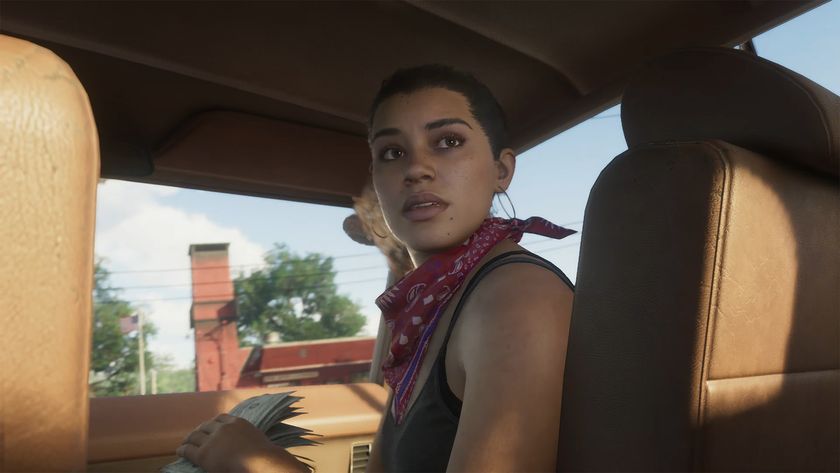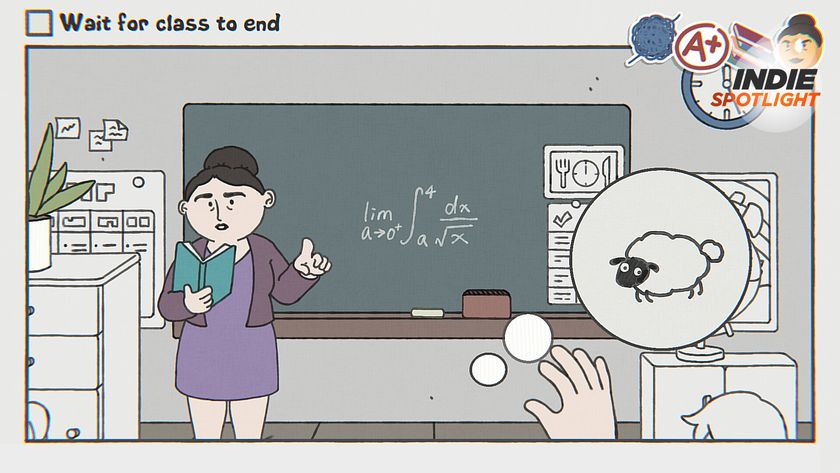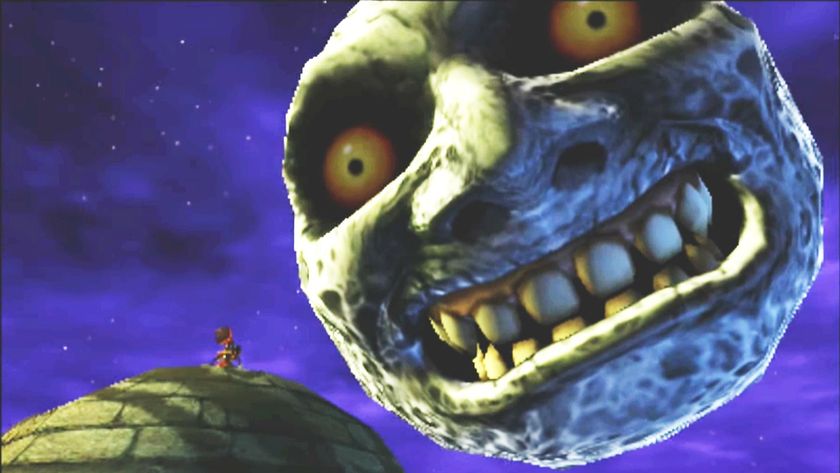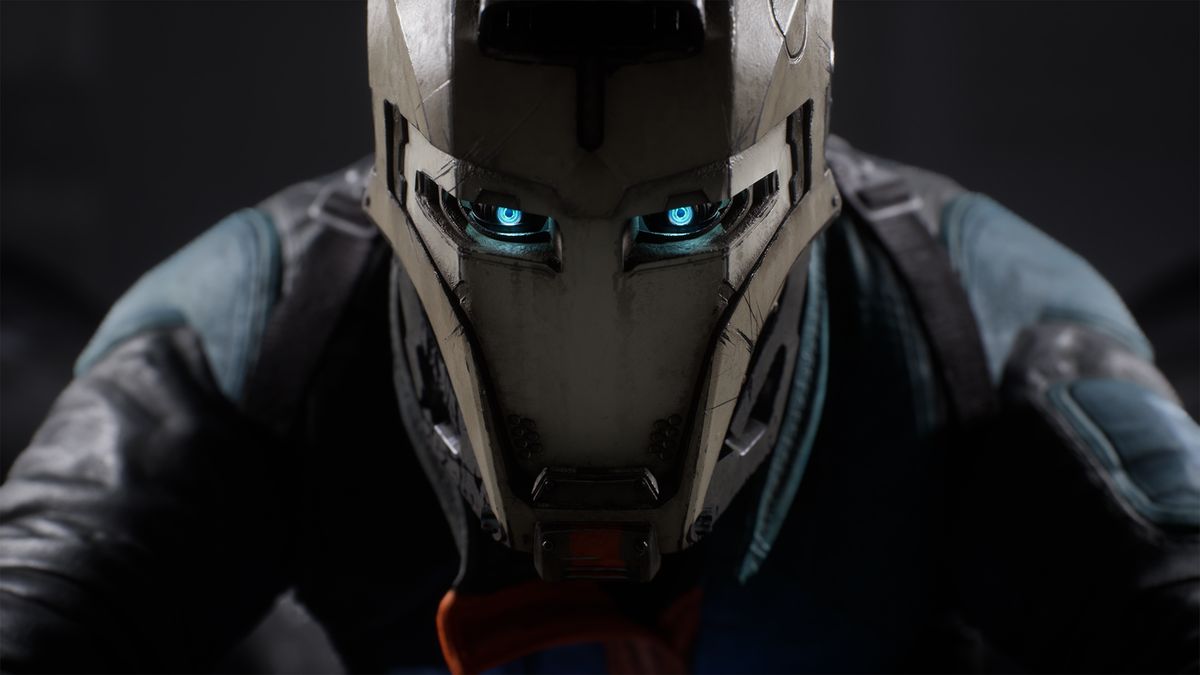
By the time Disintegration is ready to take flight next year, it'll have been a decade since Marcus Lehto last shipped a game. Halo: Reach was a crescendo of sorts for Lehto, and for the studio that the creative director called home for much of his career, Bungie, as it called time on a decade's worth of work on a series that changed the fabric of the first-person shooter. Both Lehto and Bungie set off in search of new destinies in 2010, but where Bungie reached for the stars, Lehto set his sights on something much closer to home.
Before I talk you through the nuts and bolts of Disintegration's design, you need to understand where it has come from, and the mindset of the small team working behind the scenes to make this ambitious project a reality. After all, ten years is the kind of downtime that can make the creatively inclined reflect on their past and make bold predications about the future. It's the kind of push that can make somebody like Lehto – the co-creator of Halo and of its enigmatic envoy, Master Chief – claim that his latest endeavour is going to be "unlike anything you've ever played before".

Game Disintegration
Developer V1 Interactive
Publisher Private Division
Platforms PC, PS4, Xbox One
Release 2020
It's a bold claim, even in an industry well versed in the art of unbridled hyperbole. While it might have taken Lehto ten years to get here, to a stage where he is comfortable showing V1 Interactive's debut off to the world, it took just ten minutes of playtime with Disintegration to make me believe that he might actually be onto something.
"I know that this is risky," Lehto tells me of Disintegration. "It's risky when you're working with a new IP, and with a new kind of first-person shooter that mixes in real-time tactical elements in a way that no other game does. Disintegration doesn't fit neatly into any existing genre; it carves out its own unique space. I think that it is something really cool and different. I hope that people recognise and respond to that in a positive way."
Looking back, moving forward
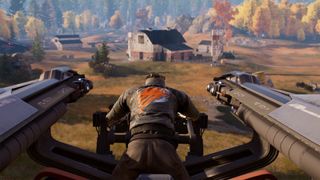
Disintegration is inherently different from anything else in the FPS space. By that fact alone, it is also inherently difficult to properly grasp its true appeal until you are able to get your hands on it for yourself. That's a problem V1 Interactive is going to have to grapple with from now until its proposed 2020 release. Looking at it broadly, Disintegration is a first-person shooter/real-time strategy hybrid; the weighting of each of these competing genres holding equal weighting in the natural flow of play.
The game tasks you with fighting to survive in a dystopian future, pushing you to engage with enemies directly in a first-person perspective from the pilot seat of a futuristic 'Gravcycle', while simultaneously commanding a squad of three AI-controlled troops on the ground. The commandeering of your ground assault squadron shouldn't be treated as an afterthought in the chaos of play, but as an integral component to finding success in Disintegration – be it across its single-player or multiplayer configurations.
That's because back in 2012, as Lehto formed V1 Interactive with just two other engineers and began to throw around early prototypes, Disintegration was envisioned as a pure RTS. Lehto was interested in returning to his roots, to the first project he worked on with Bungie. A spiritual successor of sorts to Myth: The Fallen Lords was born in these early years, the real-time tactics game released by the studio in 1997, but his ambition eventually got the better of him. "Disintegration actually started out as a pure real-time tactical game," Lehto says, laughing. "I'm not kidding you at all..."
Sign up to the 12DOVE Newsletter
Weekly digests, tales from the communities you love, and more
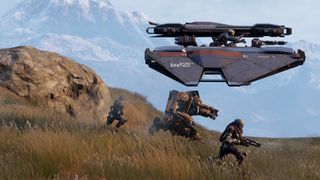
"It's risky when you're working with a new IP, and with a new kind of first-person shooter that mixes in real-time tactical elements in a way that no other game does"
Marcus Lehto, creative director
For those of you that skipped history class on late-nineties shooter design, the reason Lehto finds this so amusing is that Halo: Combat Evolved effectively started out as a reskinned, science-fiction themed version of Myth: The Fallen Lords. A small three-person team at Bungie utilised Myth's core engine, mechanics, and systems as development of Halo began in '97, and then, as the team grew along with its ambition – and as Bungie worked on engineering new ways to control units and conjure a sense of immersion from behind the wheel of vehicles – the camera steadily inched out of the sky and crept in behind the visor. That's the abridged version of how one of the most influential FPS games ever made was born.
And because this industry can so often work in mysterious ways, that's how Disintegration was born too. "It freaked me out when we first started doing it," Lehto continues. "But Disintegration quickly changed direction; we took the camera out of the sky, and we turned that into a vehicle which we call the Gravcycle. Then we allowed you to fly around and engage with the units on the ground in a different way. Eventually, we were like, alright, let's also give the GravCycle some onboard offensive and defensive weapons as well."
That's how Disintegration was born, but not how it plays. Disintegration handles its blurring of styles with ease, its execution flawlessly invigorating. Pilots are bound to Gravcycles of varying design, with several class types subsequently shifting your loadout and mobility. The AI-controlled ground squads are archetypal in design, each equipped with its own array of bespoke weaponry and special abilities such as mortar strikes, slow fields, and concussion grenades that can be activated via the D-pad and are governed by strict countdown timers. Getting your head around direct and indirect engagement with enemies and objectives is core to Disintegration's core to-and-fro. "There is a symbiotic relationship between the units and the Gravcycle pilots," Lehto tells me. "Together, they are a unit – we call them a Crew. That's really important, it's one of the main elements of the game; we want you to feel like one entity working together."
"An effective Pilot understands that bond," he continues. "They understand that the relationship between the two is mutually beneficial. You can think about it this way: that the common first-person shooter elements – the Pilot and Gravcycle – as being your right hand, and the tactical elements – your crew on the ground – is your left."
It makes sense in motion
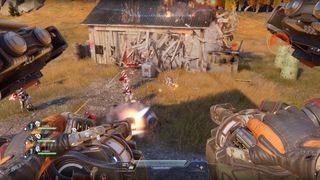
Getting hands-on with Disintegration, it quickly becomes clear that there is no easy comparison to any one FPS or RTS to be made. To suggest that it's somehow a mash-up of Destiny and Halo Wars would do all three a disservice. Truth be told, thanks to certain quirks of its design, the closest point of comparison would be to a MOBA, like League of Legends – it's a messy comparison to make, but it's there for you all the same.
In the mode I had the opportunity to play, Retrieval, the setup sees two teams of five pilots squaring up against one another, each with their own squad of three AI-troops to command. It means that at any one time there could be 40 points of conflict on the map, as Gravcycles jostle for room to manoeuvre in the tight outdoor lanes and claustrophobic indoor warehouses. The ground troopers are ultimately being directed towards Reactor Cores – Retrieval is effectively a variant of Capture the Flag, where you are tasked with running the flag directly into enemy territory rather than back to your own base – creating a criss-cross of firing lines as they do.
Lehto is only too aware of the doubts perspective players may have about Disintegration's core play. Attempting to merge the fluid action of a first-person shooter with the depth of a real-time strategy hasn't been without its problems for V1 Interactive. "It really produced some significant challenges for us," he tells me, speaking to the design challenges his team of 30 is working to overcome. "We're asking the player to fly this vehicle around from a first-person perspective and control units, so we had to figure out how to do that in a way that's really fluid, and can work seamlessly with the player's actions."
Minutes in, and it's carnage. Disintegration is a game that favours those who thrive under pressure, with all of the action unfolding across the map through pirouetting plumes of conflict and chaos. Cutting through it all to see clearly is the fun at the heart of Disintegration. Controlling the Gravcycle is a very real delight, immediately selling the FPS side to the game. It's fun to wrap a Gravcycle around a tight bend at speed, only to force an emergency ascension to avoid an incoming missile, descending quicker still to provide some amount of overhead cover to your squad. You can feel a lurch in your stomach in these moments, as you whip over the ground and into the fray – Disintegration is the sort of game that forces your eyes wide until they are dry.
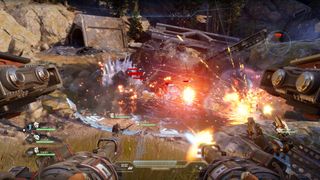
"I love Halo, and I love Destiny, but I wanted to get back to the roots of building something really fun and different"
Marcus Lehto, creative director
Juggling the micro-management of your troops and your own survivability is an exercise in stress management, particularly when trying to fend off a few Gravcycles sliding into view as enemy ground troops begin to rally into position. It's also intensely entertaining. The only units that can interact with or move the Reactor Cores are the AI ground troops, a quirk of Disintegration's design that really helps it come to life. It ensures that victory is found not in the kill count of player Pilots, but in the cover and support you can provide to the squads of ground troops. Thankfully, firing off commands is as easy and intuitive as firing a second weapon in dual wield.
"We treated commanding almost like firing a weapon in first-person. So you're firing the command calls down on the ground to tell your units to move autonomously to those locations and take up positions of cover and do smart things for you," Lehto continues. "We wanted to make sure that the player always feels like they've got the agency to do something interesting."
I enjoyed my time with Disintegration. It presents a blurred line between competing genres, and it works in ways that it probably shouldn't. While I've seen just one map so far, it was clearly play-tested and refined, continually working to funnel action into treacherous choke points that were a cathartic delight to fight my way out of. The nine Crews on offer in the Alpha build were clearly defined, each helping to shift team composition and play style opportunities in obvious and opportunistic ways. There's a long way for Disintegration to go, but this early showing has done enough to dispel my initial doubts of the hybrid model.
Disintegration is scheduled to launch in 2020 for PC, PS4, and Xbox One, and there's still plenty of work to be done before production can wrap. But Lehto is confident that the team is in a good position, that all of its hard work will be worth it in the end. Because this is something unlike anything you've ever played before. It's smartly designed and interesting, fresh and intuitive in its execution. That's why Lehto and the folks at V1 are doing this, after all. "You know, that's one of the reasons that I left Bungie. I love Halo, and I love Destiny, but I wanted to get back to the roots of building something really fun and different… I hope that people have as much fun playing it as we have had making it."
Vote for your favourite games of the year in the Golden Joystick Awards ahead of the 2019 ceremony on the 15 November.

Josh West is the Editor-in-Chief of 12DOVE. He has over 15 years experience in online and print journalism, and holds a BA (Hons) in Journalism and Feature Writing. Prior to starting his current position, Josh has served as GR+'s Features Editor and Deputy Editor of games™ magazine, and has freelanced for numerous publications including 3D Artist, Edge magazine, iCreate, Metal Hammer, Play, Retro Gamer, and SFX. Additionally, he has appeared on the BBC and ITV to provide expert comment, written for Scholastic books, edited a book for Hachette, and worked as the Assistant Producer of the Future Games Show. In his spare time, Josh likes to play bass guitar and video games. Years ago, he was in a few movies and TV shows that you've definitely seen but will never be able to spot him in.
Most Popular





